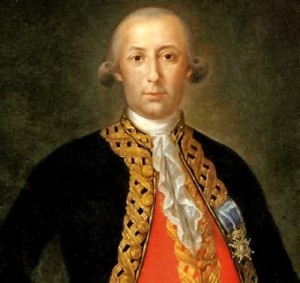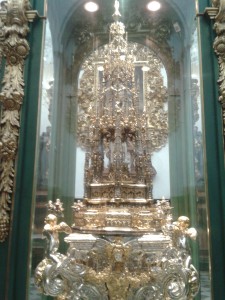Today, the Chinese have invaded our markets and taken over our stores. It is not, however, for the first time.
I learned of the influence of goods from the Far East while I was working on my novel on 1770s New Spain. We’ve already discussed the magnificent palaces built in Mexico at the time. What the owners put into the palaces is even more amazing. The lists from wills of the period indicate that the Bourbon Reforms of Carlos III had opened the homes of nearly every colonial in New Spain to goods from all over the world, but particularly China. Ostentatious display was the name of the game.
 How did the goods from the Far East get to New Spain, then across Mexico and back to Spain itself? For 250 years, from 1565 until 1815, the Spanish operated galleons that carried the Manila trade. It was the longest lasting and most profitable trade route in history. One in six didn’t make it, but those that did could guarantee a return on investment of as much as 300%.
How did the goods from the Far East get to New Spain, then across Mexico and back to Spain itself? For 250 years, from 1565 until 1815, the Spanish operated galleons that carried the Manila trade. It was the longest lasting and most profitable trade route in history. One in six didn’t make it, but those that did could guarantee a return on investment of as much as 300%.
 After Columbus discovered the islands of the Caribbean, the Portuguese complained at Spain’s intrusion into their territory. The Spanish monarchs called on Pope Alexander VI (himself an Aragonese) to help. The Pope divided the world in the Treaty of Tordesillas (1494) and the later Treaty of Zaragoza (1529) between Spain and Portugal. Portugal was to get Africa and Asia, Spain the rest. The Spanish were not happy with the treaty. They wanted India. At the time they, as yet, knew nothing of the land mass of the Americas with its wealth of gold and silver.
After Columbus discovered the islands of the Caribbean, the Portuguese complained at Spain’s intrusion into their territory. The Spanish monarchs called on Pope Alexander VI (himself an Aragonese) to help. The Pope divided the world in the Treaty of Tordesillas (1494) and the later Treaty of Zaragoza (1529) between Spain and Portugal. Portugal was to get Africa and Asia, Spain the rest. The Spanish were not happy with the treaty. They wanted India. At the time they, as yet, knew nothing of the land mass of the Americas with its wealth of gold and silver.
As soon as Balboa discovered the Pacific in 1513, the Spanish realized that they could open a route to the coveted Far East. To get there, however, their explorers learned the dangerous trip would take as much as three to four months, one way. Scurvy, lack of water, diseases and bad weather all threatened. The return trip was no easier, requiring the ships to go north as far as Japan or the Aleutians to catch the trade winds and then down the coast of California to finally reach Acapulco.
 By the 1600s, pirates had taken up residence in every bay along the coast of Mexico from Los Cabos, Mazatlan, Puerto Vallarta, Manzanillo and Zihuatanejo to await the galleon. Once can imagine them lying in hammocks sipping maitais while waiting for the sails to show up on the horizon.
By the 1600s, pirates had taken up residence in every bay along the coast of Mexico from Los Cabos, Mazatlan, Puerto Vallarta, Manzanillo and Zihuatanejo to await the galleon. Once can imagine them lying in hammocks sipping maitais while waiting for the sails to show up on the horizon.
The galleons that the Spanish built were the super-tankers of the ancient world. The first were built in Acapulco, but the best were later built in Manila. There the builders had access to teak and cordage. The 2,500 ton ‘naos de china,’ some as long as a football field, carried silver from Acapulco to China, with passengers and a crew of up to 1,000 people. The goods they brought back, however, were incredible.

 According to William L. Schurtz, in his book Manila Galleon (NY: E.P.Dutton, 1939), the ships carried porcelain, laquerware, and ivory from China; textiles such as gauzes, velvets, cantonese crepes, heavy brocades, flowered silks, taffeta, fine damask, grograins and specific items such as silk bed coverings, silk stockings, silk shawls, cloaks, kimonos, tapestries, handkerchiefs, tablecloths, napkins and Chinese rugs; pearls, semi-precious stones and cotton cloth from the Coasts of Coromandel and Malabar in India; diamonds and spices from Ceylon, pepper from Sumatra and Java; wool carpets from Persia and from the Philippines, gold, hardwood, spices, iron, beeswax, and oils.
According to William L. Schurtz, in his book Manila Galleon (NY: E.P.Dutton, 1939), the ships carried porcelain, laquerware, and ivory from China; textiles such as gauzes, velvets, cantonese crepes, heavy brocades, flowered silks, taffeta, fine damask, grograins and specific items such as silk bed coverings, silk stockings, silk shawls, cloaks, kimonos, tapestries, handkerchiefs, tablecloths, napkins and Chinese rugs; pearls, semi-precious stones and cotton cloth from the Coasts of Coromandel and Malabar in India; diamonds and spices from Ceylon, pepper from Sumatra and Java; wool carpets from Persia and from the Philippines, gold, hardwood, spices, iron, beeswax, and oils.
 Arriving in Acapulco, the goods were transported by mules up over the mountains into Mexico City then back down the mountains to Veracruz, where they were put aboard the twice-a-year silver fleet sailing from Havana to Cadiz. One of the things Bernardo de Gálvez was famous for while he was Viceroy of New Spain (1785-86 – sadly, he only lasted a little over a year), was completing the road from Acapulco to Mexico City.
Arriving in Acapulco, the goods were transported by mules up over the mountains into Mexico City then back down the mountains to Veracruz, where they were put aboard the twice-a-year silver fleet sailing from Havana to Cadiz. One of the things Bernardo de Gálvez was famous for while he was Viceroy of New Spain (1785-86 – sadly, he only lasted a little over a year), was completing the road from Acapulco to Mexico City.
The wealthy colonials in Mexico got first pick of the items coming through. Is it any wonder that their palaces were filled with goods from the Far East?


… [Trackback]
[…] Here you will find 42422 additional Information to that Topic: carolinacastillocrimm.com/tidbits-from-history-the-manila-galleons/ […]
… [Trackback]
[…] Information on that Topic: carolinacastillocrimm.com/tidbits-from-history-the-manila-galleons/ […]
… [Trackback]
[…] Here you will find 5653 additional Information on that Topic: carolinacastillocrimm.com/tidbits-from-history-the-manila-galleons/ […]
… [Trackback]
[…] Find More Information here to that Topic: carolinacastillocrimm.com/tidbits-from-history-the-manila-galleons/ […]
… [Trackback]
[…] Here you will find 24063 more Information on that Topic: carolinacastillocrimm.com/tidbits-from-history-the-manila-galleons/ […]
… [Trackback]
[…] Find More Info here to that Topic: carolinacastillocrimm.com/tidbits-from-history-the-manila-galleons/ […]
… [Trackback]
[…] Info on that Topic: carolinacastillocrimm.com/tidbits-from-history-the-manila-galleons/ […]
… [Trackback]
[…] Info to that Topic: carolinacastillocrimm.com/tidbits-from-history-the-manila-galleons/ […]
… [Trackback]
[…] Find More here on that Topic: carolinacastillocrimm.com/tidbits-from-history-the-manila-galleons/ […]
… [Trackback]
[…] There you can find 8096 more Info on that Topic: carolinacastillocrimm.com/tidbits-from-history-the-manila-galleons/ […]
… [Trackback]
[…] Info on that Topic: carolinacastillocrimm.com/tidbits-from-history-the-manila-galleons/ […]
… [Trackback]
[…] Information to that Topic: carolinacastillocrimm.com/tidbits-from-history-the-manila-galleons/ […]
… [Trackback]
[…] There you will find 15825 more Information on that Topic: carolinacastillocrimm.com/tidbits-from-history-the-manila-galleons/ […]
… [Trackback]
[…] Read More on to that Topic: carolinacastillocrimm.com/tidbits-from-history-the-manila-galleons/ […]
… [Trackback]
[…] Find More on that Topic: carolinacastillocrimm.com/tidbits-from-history-the-manila-galleons/ […]
… [Trackback]
[…] There you will find 78315 additional Information to that Topic: carolinacastillocrimm.com/tidbits-from-history-the-manila-galleons/ […]
… [Trackback]
[…] Find More on that Topic: carolinacastillocrimm.com/tidbits-from-history-the-manila-galleons/ […]
cinemakick .com
… [Trackback]
[…] Read More Info here to that Topic: carolinacastillocrimm.com/tidbits-from-history-the-manila-galleons/ […]
recipesjelly
… [Trackback]
[…] Read More Information here to that Topic: carolinacastillocrimm.com/tidbits-from-history-the-manila-galleons/ […]
… [Trackback]
[…] Read More Information here to that Topic: carolinacastillocrimm.com/tidbits-from-history-the-manila-galleons/ […]
… [Trackback]
[…] Find More on that Topic: carolinacastillocrimm.com/tidbits-from-history-the-manila-galleons/ […]
… [Trackback]
[…] There you can find 43201 additional Information on that Topic: carolinacastillocrimm.com/tidbits-from-history-the-manila-galleons/ […]
… [Trackback]
[…] Find More on to that Topic: carolinacastillocrimm.com/tidbits-from-history-the-manila-galleons/ […]
… [Trackback]
[…] There you will find 41885 additional Information on that Topic: carolinacastillocrimm.com/tidbits-from-history-the-manila-galleons/ […]
… [Trackback]
[…] There you can find 18457 more Info on that Topic: carolinacastillocrimm.com/tidbits-from-history-the-manila-galleons/ […]
… [Trackback]
[…] Information to that Topic: carolinacastillocrimm.com/tidbits-from-history-the-manila-galleons/ […]
… [Trackback]
[…] Read More on that Topic: carolinacastillocrimm.com/tidbits-from-history-the-manila-galleons/ […]
… [Trackback]
[…] Here you will find 72496 additional Information to that Topic: carolinacastillocrimm.com/tidbits-from-history-the-manila-galleons/ […]
… [Trackback]
[…] Find More Info here to that Topic: carolinacastillocrimm.com/tidbits-from-history-the-manila-galleons/ […]